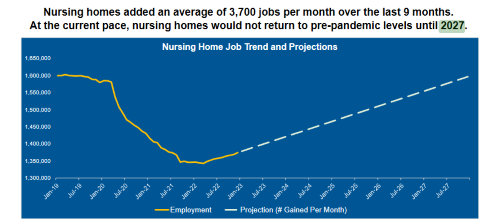
Staffing in long-term care dropped drastically at the start of the pandemic and is unlikely to rebound to pre-pandemic levels until 2027. That’s according to a recent analysis of US Census data by the American Health Care Association / National Center for Assisted Living.
“The data doesn’t lie. This is not just an exaggerated call for help, and this labor crisis will not go away on its own or through government enforcement,” AHCA / NCAL President and CEO Mark Parkinson stated, adding that the situation is particularly dire in nursing homes.
“Our nursing homes are struggling to recruit caregivers, and if we do not get meaningful assistance soon, then the consequence will be hundreds of thousands of seniors displaced,” he said. “We need immediate support, but we also need long-term investments and programs from policymakers to attract individuals to serve our nation’s seniors.”
It’s not just nursing homes that are experiencing issues, however, AHCA / NCAL noted. Assisted living communities and continuing care retirement communities also are feeling the pinch.
Key takeaways from the associations’ analysis:
- All long-term care providers collectively lost 307,000 jobs from February 2020 to December 2022. Of those, 210,000 jobs were in nursing homes, which lost 13.3% of its workforce in that time. Assisted living communities lost 4,200 jobs (0.9% of workforce) from February 2020 to November 2022. The job-related impact of the pandemic on CCRCs falls between skilled nursing and assisted living.
- Long-term care employment is at a 13-year low, and the nursing home workforce in particular is at levels not seen since 1994. In fact, nursing homes collectively have experienced the worst job loss of any healthcare sector, including physicians’ offices, hospitals, outpatient care, assisted living and home health.
- Home health, however, saw a 3.6% gain in employment (55,300 jobs) from February 2020 to December 2022.
- Nursing home job growth in 2022 slowed more than previously projected. Nursing homes added an average of 3,700 jobs per month over the past nine months. At the current pace, nursing homes would not return to pre-pandemic levels until 2027. A previous AHCA / NCAL model estimated a recovery in 2026.

Skilled nursing and assisted living operators are experiencing an “unprecedented workforce crisis,” Parkinson said previously during an online press conference announcing a new campaign to try to combat the issue. The effect of the crisis is that many facilities are limiting admissions or closing their doors altogether, AHCA / NCAL said.
Another threat hampering skilled nursing’s rebound to pre-pandemic staffing levels, AHCA/NCAL said, is the federal government’s proposed staffing minimums. Almost all respondents (95%) to an association survey in December said that they were concerned about being able to meet a staffing minimum of 4.1 hours of care per day per resident being floated by the Centers for Medicare & Medicaid Services.
“Government staffing mandates will not solve the core issue here. We need a concerted, collective effort with proper resources and incentives to help recruit more individuals to work in long-term care,” Holly Harmon, RN, AHCA/NCAL’s senior vice president of quality, regulatory and clinical services, said in a statement issued in conjunction with the December survey results.


